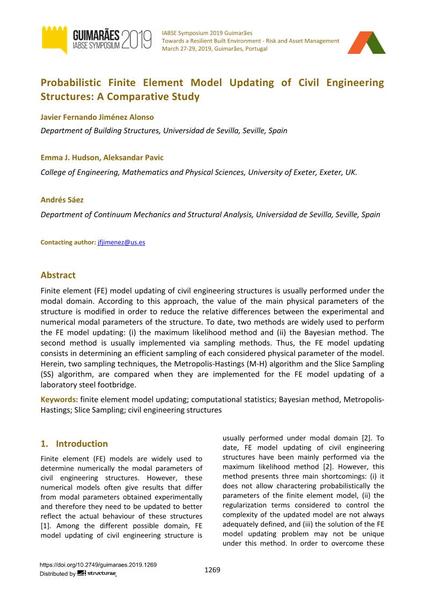Probabilistic Finite Element Model Updating of Civil Engineering Structures: A Comparative Study

|
|
|||||||||||
Bibliographic Details
| Author(s): |
Javier F. Jiménez Alonso
(Department of Building Structures, Universidad de Sevilla, Seville, Spain)
Emma J. Hudson (College of Engineering, Mathematics and Physical Sciences, University of Exeter, Exeter, UK.) Aleksandar Pavic (College of Engineering, Mathematics and Physical Sciences, University of Exeter, Exeter, UK.) Andrés Sáez |
||||
|---|---|---|---|---|---|
| Medium: | conference paper | ||||
| Language(s): | English | ||||
| Conference: | IABSE Symposium: Towards a Resilient Built Environment Risk and Asset Management, Guimarães, Portugal, 27-29 March 2019 | ||||
| Published in: | IABSE Symposium Guimarães 2019 | ||||
|
|||||
| Page(s): | 1269-1276 | ||||
| Total no. of pages: | 8 | ||||
| DOI: | 10.2749/guimaraes.2019.1269 | ||||
| Abstract: |
Finite element (FE) model updating of civil engineering structures is usually performed under the modal domain. According to this approach, the value of the main physical parameters of the structure is modified in order to reduce the relative differences between the experimental and numerical modal parameters of the structure. To date, two methods are widely used to perform the FE model updating: (i) the maximum likelihood method and (ii) the Bayesian method. The second method is usually implemented via sampling methods. Thus, the FE model updating consists in determining an efficient sampling of each considered physical parameter of the model. Herein, two sampling techniques, the Metropolis-Hastings (M-H) algorithm and the Slice Sampling (SS) algorithm, are compared when they are implemented for the FE model updating of a laboratory steel footbridge. |
||||
| Keywords: |
finite element model updating Civil Engineering structures computational statistics Bayesian method Metropolis-Hastings slice sampling
|
||||
